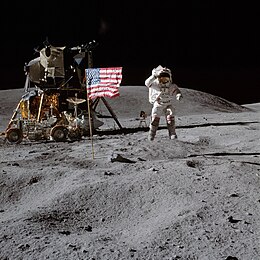 John Young saluting the United States flag while jumping up on the Moon, with the Apollo Lunar Module Orion and Lunar Roving Vehicle in the background | |
| Mission type | Crewed lunar landing (J)[1] |
|---|---|
| Operator | NASA |
| COSPAR ID | |
| SATCAT no. | |
| Mission duration | 11 days, 1 hour, 51 minutes, 5 seconds[5] |
| Spacecraft properties | |
| Spacecraft |
|
| Manufacturer |
|
| Launch mass | 52,759 kilograms (116,314 lb)[9] |
| Landing mass | 5,441 kilograms (11,995 lb)[5] |
| Crew | |
| Crew size | 3 |
| Members | |
| Callsign |
|
| EVAs | 1 in cislunar space to retrieve film cassettes |
| EVA duration | 1 h 23 min 42 s |
| Start of mission | |
| Launch date | April 16, 1972, 17:54:00 UTC |
| Rocket | Saturn V SA-511 |
| Launch site | Kennedy LC-39A |
| End of mission | |
| Recovered by | USS Ticonderoga |
| Landing date | April 27, 1972, 19:45:05 UTC[5] |
| Landing site | South Pacific Ocean 0°43′S 156°13′W / 0.717°S 156.217°W[5] |
| Lunar orbiter | |
| Spacecraft component | Command and service module |
| Orbital insertion | April 19, 1972, 20:22:27 UTC[10] |
| Orbital departure | April 25, 1972, 02:15:33 UTC[11] |
| Orbits | 64[12][13] |
| Lunar lander | |
| Spacecraft component | Lunar Module |
| Landing date | April 21, 1972, 02:23:35 UTC[14] |
| Return launch | April 24, 1972, 01:25:47 UTC[15] |
| Landing site | Descartes Highlands 8°58′23″S 15°30′01″E / 8.97301°S 15.50019°E[16] |
| Sample mass | 95.71 kilograms (211.0 lb)[17] |
| Surface EVAs | 3 |
| EVA duration | |
| Lunar rover | |
| Distance driven | 26.7 kilometers (16.6 mi)[17] |
| Docking with LM | |
| Docking date | April 16, 1972, 21:15:53 UTC[18] |
| Undocking date | April 20, 1972, 18:07:31 UTC[10] |
| Docking with LM Ascent Stage | |
| Docking date | April 24, 1972, 03:35:18 UTC[11] |
| Undocking date | April 24, 1972, 20:54:12 UTC[11] |
| Payload | |
| Mass |
|

 Left to right: Mattingly, Young, Duke | |
Apollo 16 (April 16–27, 1972) was the tenth crewed mission in the United States Apollo space program, administered by NASA, and the fifth and penultimate to land on the Moon. It was the second of Apollo's "J missions", with an extended stay on the lunar surface, a focus on science, and the use of the Lunar Roving Vehicle (LRV). The landing and exploration were in the Descartes Highlands, a site chosen because some scientists expected it to be an area formed by volcanic action, though this proved not to be the case.
The mission was crewed by Commander John Young, Lunar Module Pilot Charles Duke and Command Module Pilot Ken Mattingly. Launched from the Kennedy Space Center in Florida on April 16, 1972, Apollo 16 experienced a number of minor glitches en route to the Moon. These culminated with a problem with the spacecraft's main engine that resulted in a six-hour delay in the Moon landing as NASA managers contemplated having the astronauts abort the mission and return to Earth, before deciding the problem could be overcome. Although they permitted the lunar landing, NASA had the astronauts return from the mission one day earlier than planned.
After flying the Lunar Module to the Moon's surface on April 21, Young and Duke spent 71 hours—just under three days—on the lunar surface, during which they conducted three extravehicular activities or moonwalks, totaling 20 hours and 14 minutes. The pair drove the lunar rover, the second used on the Moon, for 26.7 kilometers (16.6 mi). On the surface, Young and Duke collected 95.8 kilograms (211 lb) of lunar samples for return to Earth, including Big Muley, the largest Moon rock collected during the Apollo missions. During this time Mattingly orbited the Moon in the command and service module (CSM), taking photos and operating scientific instruments. Mattingly, in the command module, spent 126 hours and 64 revolutions in lunar orbit.[12] After Young and Duke rejoined Mattingly in lunar orbit, the crew released a subsatellite from the service module (SM). During the return trip to Earth, Mattingly performed a one-hour spacewalk to retrieve several film cassettes from the exterior of the service module. Apollo 16 returned safely to Earth on April 27, 1972.
- ^ Orloff & Harland 2006, p. 547.
- ^ a b Orloff & Harland 2006, p. 473.
- ^ Orloff & Harland 2006, p. 476.
- ^ a b Orloff & Harland 2006, p. 573.
- ^ a b c d Orloff & Harland 2006, p. 482.
- ^ Orloff & Harland 2006, p. 472.
- ^ Orloff & Harland 2006, p. 20.
- ^ Orloff & Harland 2006, p. 26.
- ^ Orloff & Harland 2006, p. 585.
- ^ a b Orloff & Harland 2006, p. 499.
- ^ a b c Orloff & Harland 2006, p. 503.
- ^ a b Orloff & Harland 2006, p. 480.
- ^ "Apollo 16". NASA. July 8, 2009. Retrieved October 18, 2021.
- ^ Orloff & Harland 2006, p. 500.
- ^ Orloff & Harland 2006, p. 502.
- ^ a b Orloff & Harland 2006, p. 478.
- ^ a b c d Orloff & Harland 2006, p. 479.
- ^ Orloff & Harland 2006, p. 498.